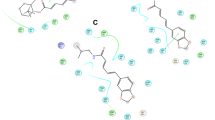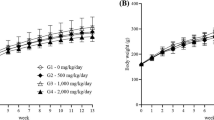Abstract
The importance of Tinospora cordifolia extract was investigated for its possible protective effect in spleen and blood in male ICR albino mice against ochratoxin A-induced toxicity (OTA). OTA instigates oxidative changes and results in the overproduction of free radicals, changes in body/organ weight, and the food consumption and is considered as a risk factor for animals and humans. Reactive oxygen species (ROS), reactive nitrogen species (RNS), and consequent lipid-peroxidative damages caused by OTA are considered to be the main mechanisms leading to oxidative stress disorders in organs and blood. TC oral administrations prevent the physiological status of animals and improve the biochemical parameters of the urine and plasma. Moreover, EPR analysis show that TC administration decreased Asc• and NO• radicals and ROS productions in the spleen and serum, even in OTA-treated group. The significant decrease in MDA formation in the spleen and serum and the increased expression of SOD activity in TC and TC + OTA groups confirm the positive modulatory effect of TC extract on the cellular antioxidant system. TC and TC + OTA treatment caused significant reduction of genotoxic potential (8-OHdG) of OTA, followed by a decreased oxidative activity and gradual recovery of ROS-induced DNA damage. The results suggested that TC extract protect against OTA-induced oxidative disorders and other abnormalities. As typical antioxidant TC could protect splenic macrophages and regain intracellular antioxidant capacity.




Similar content being viewed by others
References
Agarwal A, Malini S, Bairy KL, Rao MS (2002) Effect of Tinospora cordifolia on learning and memory in normal and memory deficit rats. Indian J Pharm 34(5):339–349
Birben E, Sahiner UM, Sackesen C, Erzurum S, Kalayci O (2012) Oxidative stress and antioxidant defense. World Allergy Organ J 5(1):9–19
Buettner GR, Jurkiewicz BA (1993) Ascorbate free-radical as a marker of oxidative stress––an EPR study. Free Radic Biol Med 14(1):49–55
Cavin C, Delatour T, Marin-Kuan M, Holzhäuser D, Higgins L, Bezençon C, Guignard G, Junod S, Richoz-Payot J, Gremaud E, Hayes JD, Nestler S, Mantle P, Schilter B (2007) Reduction in antioxidant defenses may contribute to ochratoxin a toxicity and carcinogenicity. Toxicol Sci 96:30–39
Chakraborty B, Sengupta M (2012) Supporting the immune system through functional modulation of carbon tetrachloride intoxicated splenic macrophages by administering Tinospora cordifolia. J Appl Pharm Sci 02(07):117–124
Creppy EE, Kane A, Dirheimer G, Lafarge-Frayssinet C, Mousset S, Frayssinet C (1985) Genotoxicity of ochratoxin A in mice: DNA single-strand break evaluation in spleen, liver and kidney. Toxicol Lett 28(1):29–35
Denli M, Perez JF (2010) Ochratoxins in feed, a risk for animal and human health: control strategies. Toxins 2(5):1065–1077
Elaroussi MA, Mohamed FR, El Barkouky EM et al (2006) Experimental ochratoxicosis in broiler chickens. Avian Pathol 35(4):263–269
Gacche RN, Dhole NA (2011) Profile of aldose reductase inhibition, anti-cataract and free radical scavenging activity of selected medicinal plants: an attempt to standardize the botanicals for amelioration of diabetes complications. Food Chem Toxicol 49(8):1806–1813
Gupta R, Sharma V (2011) Ameliorative effects of Tinospora cordifolia root extract on histopathological and biochemical changes induced by aflatoxin-b (1) in mice kidney. Toxicol Int 18(2):94–98
Ivanova D, Gerova D, Chervenkov T et al (2005) Polyphenols and antioxidant capacity of Bulgarian medicinal plants. J Ethnopharmacol 97(1–2):145–150
Jagetia GC, Baliga MS (2004) The evaluation of nitric oxide scavenging activity of certain Indian medicinal plants in vitro: a preliminary study. J Med Food 7(3):343–348
Joshi G, Kaur R (2016) Tinospora cordifolia: a phytopharmacological review. Int J Pharm Sci Res 7(3):890
Kapil A, Sharma S (1997) Immunopotentiating compounds from Tinospora cordifolia. J Ethnopharmacol 58(2):89–95
Khan S, Martin M, Bartsch B, Rahimtula AD (1989) Perturbation of liver microsomal calcium homeostasis by ochratoxin A. Biochem Pharmacol 38(1):67–72
Kőszegi T, Poór M (2016) Ochratoxin a: molecular interactions, mechanisms of toxicity and prevention at the molecular level. Toxins 8(4):111–117
Kuroda K, Hibi D, Ishii Y, Takasu S, Kijima A, Matsushita K, Masumura KI, Watanabe M, Sugita-Konishi Y, Sakai H, Yanai T, Nohmi T, Ogawa K, Umemura T (2014) Ochratoxin A induces DNA double-strand breaks and large deletion mutations in the carcinogenic target site of GPT delta rats. Mutagen 29(1):27–36
Mantle PG (2008) Interpretation of the pharmacokinetics of ochratoxin A in blood plasma of rats, during and after acute or chronic ingestion. Food Chem Toxicol 46(5):1808–1816
Milićević DR, Jurić VB, Stefanović SM, Vesković-Moračanin SM, Janković SD (2009) Evaluation and validation of two different chromatographic methods (HPLC and LC-MS/MS) for the determination and confirmation of ochratoxin A in pig tissues. J Environ Sci Health B 44(8):781–787
Omar RF, Hasinoff BB, Mejilla F, Rahimtula AD (1990) Mechanism of ochratoxin A stimulated lipid peroxidation. Biochem Pharmacol 40:1183–1191
Padayatty SJ, Katz A, Wang Y, Eck P, Kwon O, Lee JH, Chen S, Corpe C, Dutta A, Dutta SK, Levine M (2003) Vitamin C as an antioxidant: evaluation of its role in disease prevention. J Am Coll Nutr 22(1):18–35
Padma VV, Baskaran R, Divya S, Priya LB, Saranya S (2016) Modulatory effect of Tinospora cordifolia extract on Cd-induced oxidative stress in Wistar rats. Integr Med Res 5(1):48–55
Patel MB, Mishra S (2011) Hypoglycemic activity of alkaloidal fraction of Tinospora cordifolia. Phytomedicine 18(12):1045–1052
Plaser ZA, Cushman LL, Jonson BC (1966) Estimation of product of lipid peroxidation (Malonyl Dialdehyde) in biochemical systems. Anal Biochem 16(2):359–364
Premanath R, Lakshmidevi N (2010) Studies on anti-oxidant activity of Tinospora cordifolia (Miers.) leaves using in vitro models. J Am Sci 6(10):736–743
Rahimtula AD, Bereziat JC, Eussacchini-Griot V et al (1988) Lipid peroxidation as a possible cause of ochratoxin a toxicity. Biochem Pharmacol 37(23):4469–4477
Rawal A, Muddeshwar M, Biswas S (2004) Effect of rubia cordifolia, Fagonia cretica Linn, and Tinospora cordifolia on free radical generation and lipid peroxidation during oxygen-glucose deprivation in rat hippocampal slices. Biochem Biophys Res Commun 324(2):588–596
Reddy SS, Ramatholisamma P, Karuna R, Saralakumari D (2009) Preventive effect of Tinospora cordifolia against high-fructose diet-induced insulin resistance and oxidative stress in male Wistar rats. Food Chem Toxicol 47(9):2224–2229
Rutigliano L, Valentini L, Martino NA, Pizzi F, Zanghì A, Dell’Aquila ME, Minervini F (2015) Ochratoxin A at low concentrations inhibits in vitro growth of canine umbilical cord matrix mesenchymal stem cells through oxidative chromatin and DNA damage. Reprod Toxicol 57:121–129
Saad M, Abdel-Fattah SM (2008) A food additive formula to minimize the negative effects due to ingesting aflatoxin(s) contaminated food. J Saudi Soc Food Nutr 3(1):17–31
Saha S, Ghosh S (2012) Tinospora cordifolia: one plant, many roles. Anc Sci Life 31(4):151–159
Sai KS, Srividya N (2002) Blood glucose lowering effect of the leaves of Tinospora cordifoliaand Sauropus androgynus in diabetic subjects. J Nat Remedies 2:28–32
Sangeetha MK, Balaji RHR, Gayathri V et al (2011) Tinospora cordifolia attenuates oxidative stress and distorted carbohydrate metabolism in experimentally induced type 2 diabetes in rats. Nat Med 65(3–4):544–550
Schraufstatter IU, Hyslop PA, Jackson JH, Cochrane CG (1988) Oxidant-induced DNA damage of target cells. J Clin Invest 82(3):1040–1050
Sharma U, Bala M, Kumar N, Singh B, Munshi RK, Bhalerao S (2012) Immunomodulatory active compounds from Tinospora cordifolia. J Ethnopharmacol 141(3):918–926
Sharma R, Amin H, Pradeep G, Prajapatia K (2015) Antidiabetic claims of Tinospora cordifolia (Willd.) Miers: critical appraisal and role in therapy. Asian Pac J Trop Biomed 5(1):68–78
Shi HH, Sui YX, Wang XR, Luo Y, Ji L (2005) Hydroxyl radical production and oxidative damage induced by cadmium and naphthalene in liver of Carassius auratus. Comp Biochem Physiol Part C Toxicol Pharmacol 140(1):115–121
Shivananjappa MM (2012) Muralidhara abrogation of maternal and fetal oxidative stress in the streptozotocin-induced diabetic rat by dietary supplements of Tinospora cordifolia. Nutrition 28(5):581–587
Singh RP, Banerjee S, Kumar PV et al (2006) Tinospora cordifolia induces enzymes of carcinogen/drug metabolism and antioxidant system, and inhibits lipid peroxidation in mice. Phytomed 13(1):74–84
Singh L, Tyagi S, Rizvi MA et al (2007) Effect of Tinospora cordifolia on gamma ray-induced perturbations in macrophages and splenocytes. J Radiat Res 48(4):305–315
Sorrenti V, di Giacomo C, Acquaviva R, Barbagallo I, Bognanno M, Galvano F (2013) Toxicity of ochratoxin A and its modulation by antioxidants: a review. Toxins 5(10):1742–1766
Spasojevic I, Miriyala S, Tovmasyan A, Salvemini D, Fan P, Vujaskovic Z, Batinic-Haberle I, Clair DKS (2011) Lipophilicity of Mn (III) N-alkylpyridylporphyrins dominates their accumulation within mitochondria and therefore in vivo efficacy: a mouse study. Free Radic Biol Med 51:S98–S99
Stanely P, Prince M, Menon VP (2000) Hypoglycaemic and other related actions of Tinospora cordifolia roots in alloxan-induced diabetic rats. J Ethnopharmacol 70(1):9–15
Stanely M, Prince P, Menon VP (2003) Hypoglycaemic and hypolipidaemic action of alcohol extract of Tinospora cordifolia roots in chemical induced diabetes in rats. Phytother Res 17(4):410–413
Stoev SD, Goundasheva D, Mirtcheva T, Mantle P (2000) Susceptibility to secondary bacterial infections in growing pigs as an early response in ochratoxicosis. Exp Toxicol Pathol 52(4):287–296
Stoev S, Daskalov H, Radicc B, Domijanc AM, Peraicac M (2002) Spontaneous mycotoxic nephropathy in Bulgarian chickens with unclarified mycotoxin aetiology. Vet Res 33:83–93
Subramanian M, Chintalwar GJ, Chattopadhyay S (2002) Antioxidant properties of a Tinospora cordifolia polysaccharide against iron-mediated lipid damage and gamma-ray induced protein damage. Redox Rep 7(3):137–143
Sun Y, Oberley LW, Li Y (1988) A simple method for clinical assay of superoxide dismutase. Clin Chem 34(3):497–500
Upadhyay AK, Kumar K, Kumar A, Mishra HS (2010) Tinospora cordifolia (Willd.) Hook. f. and Thoms. (Guduchi)-validation of the Ayurvedic pharmacology through experimental and clinical studies. Int J Ayurveda Res 1(2):112–121
Upadhyaya R, Sharma V, Anita KV (2011) Assessment of the multifaceted immunomodulatory potential of the aqueous extract of Tinospora cordifolia. Res J Chem Sci 1(6):71–79
Wink DA, Hines HB, Cheng RYS, Switzer CH, Flores-Santana W, Vitek MP, Ridnour LA, Colton CA (2011) Nitric oxide and redox mechanisms in the immune response. J Leukoc Biol 89(6):873–891
Yabuki M, Kariya S, Ishisaka R, Yasuda T, Yoshioka T, Horton AA, Utsumi K (1999) Resistance to nitric oxide-mediated apoptosis in HL-60 variant cells is associated with increased activities of Cu-Zn-superoxide dismutase and catalase. Free Radic Biol Med 26(3):325–332
Yokoyama K, Hashiba K, Wakabayashi H, Hashimoto K, Satoh K, Kurihara T, Motohashi N, Sakagami H (2004) Inhibition of LPS stimulated NO production in mouse macrophage-like cells by tropolones. Anticancer Res 24(6):3917–3922
Yoshioka T, Iwamoto N, Ito K (1996) An application of electron paramagnetic resonance to evaluate nitric oxide and its quenchers. J Am Soc Nephrol 7(6):961–965
Zepnik H, Wolfgang V, Dekant W (2003) Toxicokinetics of the mycotoxin ochratoxin A in F 344 rats after oral administration. Toxicol Appl Pharmacol 192(1):36–44
Acknowledgments
This work was supported by the scientific project no. 6/2015 of Medical Faculty, Trakia University, Stara Zagora, Bulgaria.
Author information
Authors and Affiliations
Corresponding author
Ethics declarations
Ethical approval
All applicable international, national, and/or institutional guidelines for the care and use of animals were followed (Directive 2010/63/EU on the protection of animals used for experimental and other scientific work, and approved by the Ethical Committee for Animals of BABH and Trakia University, Stara Zagora, Bulgaria (131/6000-0333/09.12.2015). This article does not contain any studies with human participants performed by any of the authors.
Conflict of interest
The authors declare that they have no conflict of interest.
Rights and permissions
About this article
Cite this article
Karamalakova, Y., Nikolova, G., Adhikari, M. et al. Oxidative-protective effects of Tinospora cordifolia extract on plasma and spleen cells after experimental ochratoxicosis. Comp Clin Pathol 27, 1487–1495 (2018). https://doi.org/10.1007/s00580-018-2761-y
Received:
Accepted:
Published:
Issue Date:
DOI: https://doi.org/10.1007/s00580-018-2761-y




